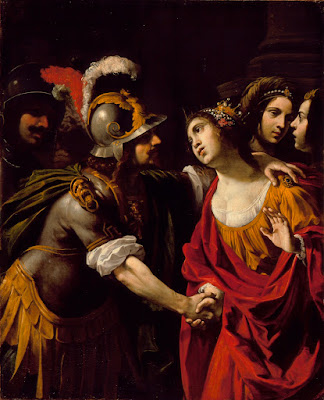 |
| Giovanni Andrea Donducci (il Mastelletta) The Deposition ca. 1625 oil on canvas private collection |
 |
| Domenico Fiasella (il Sarzana) The Baptism of Christ (detail) ca. 1625 oil on canvas Museo di Sant' Agostino, Genoa |
 |
| Gérard Douffet Beheading of St John the Baptist ca. 1625 oil on canvas private collection |
 |
| Gérard Douffet Pope Nicholas V visiting the Tomb of St Francis of Assisi 1627 oil on canvas Staatsgalerie, Neuburg |
 |
| Valentin de Boulogne The Last Supper 1625-26 oil on canvas Palazzo Barberini, Rome |
 |
| Pietro Paolini (il Lucchese) Bacchic Concert ca. 1625-30 oil on canvas Dallas Museum of Art, Texas |
"In another very important matter painters have always been different: in their greater or lesser attention to investigating the perfection of the beautiful. Some, in imitating one or more kinds of things and seeking only to imitate what usually appears to the visual faculty, have aimed at the perfect imitation of nature, as it appears to the eye, without seeking anything more. But others raise their understanding higher and comprehend in their idea the excellence of beauty and of perfection that nature wishes to produce even though it does not produce it in a single subject because of the many obstacles getting in the way, having to do with time, matter, and so forth. These great artists know that if nature is unable to achieve total perfection in the individual, it tries at least to achieve this piecemeal in many individuals, making one perfect in one thing, another perfect in another, all separately. Likewise, not content to imitate what they see in a single subject, they go about collecting the beauties dispersed in many, use their fine judgment to unite them, and make things not as they are but as they would be if they were brought into being most perfectly. From this there should be no doubt about the degree of praise those painters deserve who only imitate things as they are found in nature; and they must be given the same appreciation that the common people give them, because, never attaining knowledge of the beauty that nature wishes to express, they stop at what they see actually expressed, even though they find it very imperfect. This is why things depicted and imitated from nature please the common people, who usually see them in this way and delight in the imitation of what they fully know. But the man with understanding, raising his thoughts to the idea of beauty to which nature apparently aspires, is borne away by that and contemplates it as a divine thing."
 |
| Nicolas Régnier Fortune Teller 1626 oil on canvas Musée du Louvre |
 |
| Guido Reni Venus and Cupid 1626 oil on canvas Toledo Museum of Art, Ohio |
 |
| Guido Reni The Abduction of Helen of Troy ca. 1626-29 oil on canvas Musée du Louvre |
 |
| Bernardino Cervi Idealized Portraits of Alforisio and Acarino d'Este as Ancient Romans 1627-28 oil on canvas Palazzo dei Musei, Modena |
 |
| Bernardino Cervi Idealized Portraits of Aurelio and Tiberio d'Este as Ancient Romans 1627-28 oil on canvas Palazzo dei Musei, Modena |
"We do not wish to deny the proper praise to painters who paint excellent portraits. True, the most perfect practice calls not for seeking to depict what the face of Alexander or of Caesar might have been but rather for seeking to depict what a king and a magnanimous and strong captain should be. Nonetheless, the most valiant painters, without straying from likeness, have aided nature by art and represented faces more beautifully and more comely than the truth, showing that even in this sort of work they can determine how nature would have added more beauty to their subject in order to perfect it."
 |
| Rutilio Manetti Dido and Aeneas ca. 1630 oil on canvas Los Angeles County Museum of Art |
 |
| Giuseppe Vermiglio Dead Christ supported by Angels ca. 1628 oil on canvas Musée des Beaux-Arts de Marseille |
 |
| Giovanni Andrea Ansaldo The Deposition ca. 1630 oil on canvas Accademia Ligustica di Belle Arti, Genoa |
 |
| Gioacchino Assereto Martyrdom of St Bartholomew (detail) ca. 1630 oil on canvas Accademia Ligustica di Belle Arti, Genoa |
– quoted passages by Giovanni Battista Agucchi, from his Treatise on Painting (ca. 1615), translated by Brendan Dooley (1995)